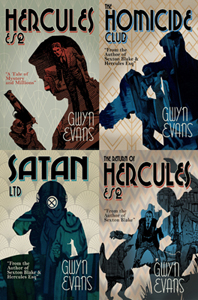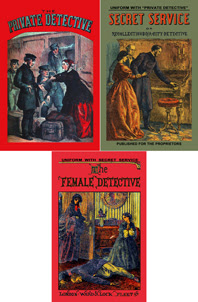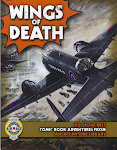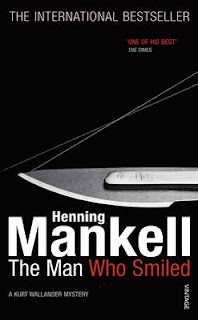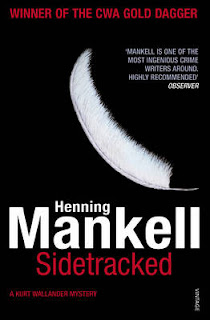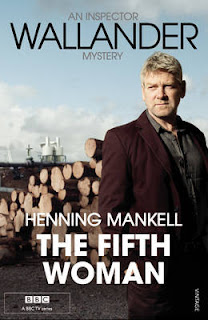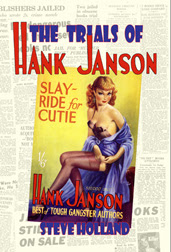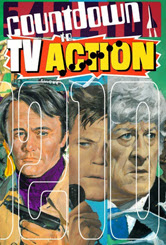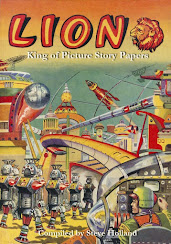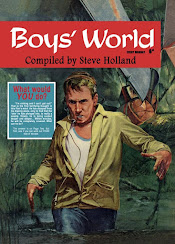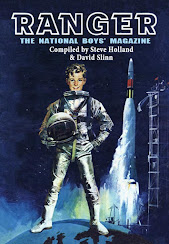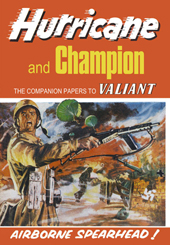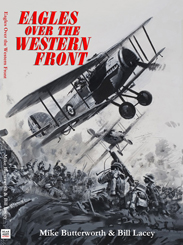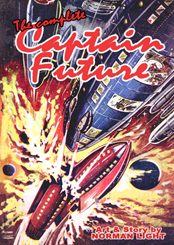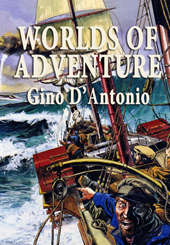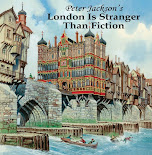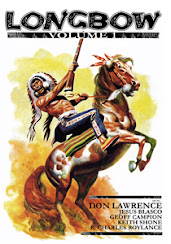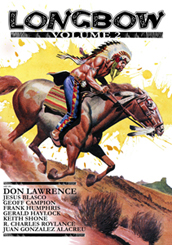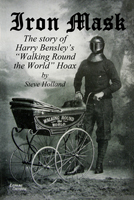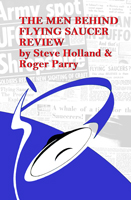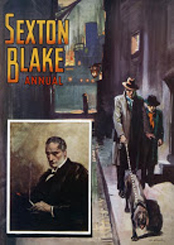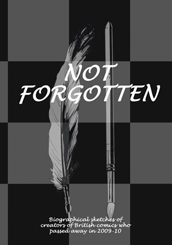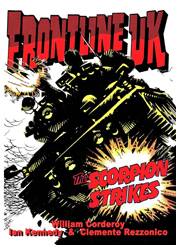I've had a quiet week with the occasional minor frustration and the occasional minor triumph to punctuate the days. I've been putting in a lot of effort to piece together the story of an author who worked in both the UK and USA and whose writing career came to a tragic end. There are still a few gaps that I need to fill and I'm trying to figure out what would be the best way to present the results.
It's going to take me a while to write up the results anyway because I'm back to the grindstone of Hotel Business and I need to think about not only the December issue, but also the January issue, where the deadline is fairly close to new year and I'll need to get as much in before Christmas as possible. So the rather patchy appearance of new articles on Bear Alley is likely to continue for the foreseeable future. If I can find subjects that I can cobble together quickly, I'll do so, but a lot of the research I'm doing at the moment requires a lot of research for very little reward... every paragraph can take an hour to write as I have to fact-check every single sentence. Who'd'a thought Wikipedia could be so unreliable or lacking in detail? That Google searches could turn up nothing? We're so used to just looking up things on the internet nowadays – and I'm doing it constantly for work – that it can be quite a blow when the answer isn't instantly available.
While I'm thinking about problems... one of the main ones is that I'm not a bottomless money-pit and I'm having to spend a little cash on reference material. This week I tried to purchase three books only to find that two of them were unavailable; the third, I'm pleased to say, arrived well-packaged and safe, so it's not all bad news. It was, however, a little frustrating as it's not the first time I've ordered things online only to find they've sold... and, indeed, the two books I tried to buy are still listed as available.
Since the cheapest copies aren't available (I need them to read, so condition isn't always vital), I'll have to figure out what my next move is. I like to have books to hand, but as the price rises, it begins to make more sense for me to spend the money on a train ticket and head down to the British Library, especially if I have three, four or more books to check out that would otherwise cost a fortune. It's nice to have the books conveniently in my possession to refer to, but sometimes the cost just isn't worth it.
The research is taking me down all sorts of odd alleyways. At the moment I'm quite interested in the language used in gangster thrillers in the 1930s. There are phrases or slang terms that I've stumbled upon that I know nothing about as they're not commonly used these days. For instance, a "Parthian shot" is an archaic version of what today we would call a "parting shot", perhaps a rejoinder made just as you leave. It makes sense that some folks, mishearing "Parthian shot" would say "parting shot". But apparently, "parting shot" predates "Parthian shot"... at least that's what Wikipedia says.
The other term that I learned this week was "taxi-dancer", which I hadn't heard before but which I'd seen only recently when I watched They Drive By Night, the 1938 movie base on a novel by James Curtis. The term appeared in a James Hadley Chase novel published in 1939 but was actually quite common in the 1920s. In the days of the Palais-de-Dance, dancers were available to hire for a fee, often in the form of tickets paid for at the door.
In Man Bait (1927) Marie Prevost played an alluring shop girl who is fired after she fends off with her fists the advances of a customer; she ends up as a taxi-dancer in a cheap dance hall where she meets the son of a millionaire. Joan Crawford in The Taxi Dancer (1928), Barbara Stanwyck in Ten Cents a Dance (1931) and Nancy Carroll in Child of Manhattan (1933) all played New York taxi dancers.
In 1933, a Reuters news report on the low wages paid to women in Shanghai, noted that "Many Russian girls have been forced to earn their living as "taxi" dancers in cabarets, but so far no British women has sought this means to make money." Apparently, Shanghai's taxi-dancers were notorious; they certainly caught the eye of Harry Greenwall when he penned Pacific Scene (1938) about his travels in the far east.
In They Drive By Night, recently released from prison, Shorty Matthews (Emlyn Williams) goes to visit his former girlfriend only to find her dead in her apartment. Fearing the police will pin the murder on him, he goes on the run; he first heads north, hitching a lift with a lorry driver (hence the title), but after a run-in with the police en route decides to return to London to clear his name. This he does with the aid of Molly (Anna Konstam), who questions clients at the dance hall where she works as a hostess.
Interesting where a single phrase can take you... and now I've spent even longer explaining it. Now you see why researching a book takes me such a horrific amount of time!
Our random scans this week are a bunch of steampunk titles by George Mann, although inspired by my stumbling upon a copy of K. W. Jeter's Infernal Devices when I took my Mum down the pub for lunch on Tuesday. Any excuse to show these off.
Friday, October 30, 2015
Friday, October 23, 2015
Comic Cuts - 23 October 2015
The week has sailed past without making much of an impact. With Mel back from the US, we had a lazy weekend trying to catch up on some TV... and we've been playing catch-up over the whole week. I'm also playing catch-up with a whole load of DVDs that have started to pile up, so I've been watching an odd mix of films. The last few I've watched have been Death Of A President (2006, dir. Gabriel Range), which was a gripping docudrama set around the fictional assassination of George W. Bush; Mordecai (2015, dir. David Koepp), which was a missed opportunity made worse by Johnny Depp trying to channel Terry-Thomas; Monsters: Dark Continent (2014, dir. Tom Green), which was harrowing in its war scenes, but there was nothing new, and the addition of alien invaders added nothing of substance; 3 Days To Kill (2014, dir. McG), which was, I suspect, meant to be a heart-warming tale of an assassin reconnecting with his estranged daughter, but which actually left me feeling bored; Super (2010, dir. James Gunn), which was a bit like a low-budget Kick-Ass with more violence and a few laughs... I need to see it again to figure out if I actually like it or not; and 2046 (2004, dir. Wong Kar-Wai), which I watched and then immediately had to read the summary for on Wikipedia just to get the storyline straight in my head. Beautiful, elegant and the sort of film where you see something and spend the next five minutes wondering whether it's significant or not. Why are we watching their shoes? Is that symbolic of something? Why is it always Christmas Eve?
Anyway, between that lot and a box set of Lie To Me season one (seen before, but Tim Roth is always worth watching again) I seem to have spent my entire week looking at a screen.
The most entertaining movie experience of the week was actually something I heard. I decided to break the back of the James Hadley Chase cover gallery without realising quite how many different covers we were talking about. I had about 90-100 in place when we started. I've just counted up the finished total: 344 – by a long-shot the most comprehensive cover gallery I've managed to date.
While I've been working on all these covers, I've been listening to a handful of newly discovered podcasts. The best of these has been The Secret History of Hollywood, narrated by a guy called Adam Roche. It has had only a handful of episodes but they're incredibly long and detailed. I've listened to the three-part biography of Alfred Hitchcock, which runs for an astonishing 19 hours and 40 minutes. I've also listened to "A Universe of Horrors" (about Universal horror stars Dracula, Frankenstein's monster, the Wolfman and the Mummy), a mere 7 hours, and Basil Rathbone's Sherlock Holmes outings, which is a blink-and-you'll-miss-it 2hrs 20mins.
The research that has gone into them is amazing. Adam Roche also runs another classic movies podcast, Attaboy Clarence, which I've yet to explore but which I'll be taking a look at shortly.
My other new favourite is the Adam Buxton Podcast. Buxton we've followed since the days of the Adam and Joe Show on Channel 4. He's always entertaining, whether its on radio (his 6Music shows Adam & Joe and Big Mix Tape are classics), on TV (it was tragic that BUG didn't last longer), or online (check out his YouTube channel); he recently co-wrote a sitcom pilot (The Cloud) with Graham Linehan, which will hopefully develop into a series.
Today's random scans are a number of editions of the same book, which I happen to be reading at the moment.
Anyway, between that lot and a box set of Lie To Me season one (seen before, but Tim Roth is always worth watching again) I seem to have spent my entire week looking at a screen.
The most entertaining movie experience of the week was actually something I heard. I decided to break the back of the James Hadley Chase cover gallery without realising quite how many different covers we were talking about. I had about 90-100 in place when we started. I've just counted up the finished total: 344 – by a long-shot the most comprehensive cover gallery I've managed to date.
While I've been working on all these covers, I've been listening to a handful of newly discovered podcasts. The best of these has been The Secret History of Hollywood, narrated by a guy called Adam Roche. It has had only a handful of episodes but they're incredibly long and detailed. I've listened to the three-part biography of Alfred Hitchcock, which runs for an astonishing 19 hours and 40 minutes. I've also listened to "A Universe of Horrors" (about Universal horror stars Dracula, Frankenstein's monster, the Wolfman and the Mummy), a mere 7 hours, and Basil Rathbone's Sherlock Holmes outings, which is a blink-and-you'll-miss-it 2hrs 20mins.
The research that has gone into them is amazing. Adam Roche also runs another classic movies podcast, Attaboy Clarence, which I've yet to explore but which I'll be taking a look at shortly.
My other new favourite is the Adam Buxton Podcast. Buxton we've followed since the days of the Adam and Joe Show on Channel 4. He's always entertaining, whether its on radio (his 6Music shows Adam & Joe and Big Mix Tape are classics), on TV (it was tragic that BUG didn't last longer), or online (check out his YouTube channel); he recently co-wrote a sitcom pilot (The Cloud) with Graham Linehan, which will hopefully develop into a series.
Today's random scans are a number of editions of the same book, which I happen to be reading at the moment.
Thursday, October 22, 2015
Commando issues 4855-4858
Commando issues on sale 22 October 2015.
Commando No 4855 – Eagles Of Dunkirk
Corporal Sean Carrick excelled as an anti-tank gunner in a Daimler Dingo scout car, whether at Dunkirk or in the cruel heat of the North African desert.
However, when an age-old family feud is re-kindled, Sean soon finds himself fighting to save his reputation as outrageous lies are spread about his past. His dilemma is that his true life story may be even more dangerous to reveal.
This particular Eagle Of Dunkirk would have to fight ‘friend’ as well as foe to be able to stretch his wings and escape a deadly destiny.
Introduction
With only a few notable exceptions — step forward the Convict Commandos — recurring characters have been rare on the pages of Commando over the last 50-odd years. However, we were of the opinion that you, our readers, might like a series which carried the story over more than one issue. With the pen of Ferg Handley recruited to do the writing, we decided that a historical saga spanning many generations would hit the spot.
After the thrilling events of the previous instalment set in the trenches of the Great War, our generation-spanning epic tale of three inter-linked, entirely fictional families is nearing journey’s end. Now we are in familiar Commando territory, World War II — more specifically the frantic retreat at Dunkirk and then the killing zone of the arid North African Desert. We hope you enjoy this story of courage and honour.
The stunning conclusion to this 13-story saga will be coming soon. Don’t’ miss it!—Scott Montgomery, Deputy Editor
Story: Ferg Handley
Art: Keith Page
Cover: Keith Page
Commando No 4856 – No Escape!
All along the British lines the terrifying news spread like wildfire.
Brave men trembled. “He’s in our area. The Engineer of Death is here!” For they knew that once “the engineer” had set his fiendish secret traps, no one who fell into them would ever walk away.
That’s when an unlikely hero volunteered, vowing to beat him at his own game. A skinny little genius with glasses, whose name was Percy Potts…
Introduction
It may not come as too much of a surprise to learn that the working title of this book was “Engineer Of Death”. This fairly lurid phrase is alluded to several times throughout the text and cleverly foreshadows this character, building him up as a fearsome adversary for our mild-mannered hero and arch rival, Percy Potts.
In typical Commando fashion, however, when the two finally meet, things don’t quite turn out the way we might expect them to.—Scott Montgomery, Deputy Editor
Story: Bounds
Art: C.T. Rigby
Cover: Davis
Originally Commando No 194 (December 1965)
Commando No 4857 – Red Ace
Sergeant Alek Pavlikov had hardly any flying hours under his belt but still felt ready to join in the fight against the Luftwaffe in the battle for supremacy of the skies above Kursk.
His dreams of heroism were soon overtaken by a dawning realisation that a surprising number of his fellow rookies were dying on their first mission.
Alek wondered if a ruthless superior officer had something to do with it. Was his fearsome major, Yuri Zaleski — the Red Ace — willing to risk Alek’s annihilation in a quest for personal glory?
Story: Ferg Handley
Art: Morahin
Cover: Janek Matysiak
Commando No 4858 – Danger Ahead
A stretch of treacherous water to cross, and no boat to do it in…
All they had was a few plywood drop tanks jettisoned from aircraft, lengths of bamboo, bits of wood…and their courage.
Yes, they needed courage most of all, for entering that stretch of water risked a horrifying death. In the search for survival there was deadly danger ahead…
Introduction
I’d like to imagine — or certainly hope — that at least one Commando reader from the mid-1970s may have since asked, “Remember the one where a joiner made a raft out of old junk, battled hungry sharks and then helped fight the Japanese…?”
Well, this is that very book!
Our resourceful carpenter hero, “Chippy” Stark, emerges from some fairly standard Aussie/Pom rivalry to become a true Commando hero in this offbeat classic.—Scott Montgomery, Deputy Editor
Story: Lomas
Art: Cueto
Cover: Ian Kennedy
Originally Commando No 1018 (March 1976), re-issued as No 2356 (March 1990)
Commando No 4855 – Eagles Of Dunkirk
Corporal Sean Carrick excelled as an anti-tank gunner in a Daimler Dingo scout car, whether at Dunkirk or in the cruel heat of the North African desert.
However, when an age-old family feud is re-kindled, Sean soon finds himself fighting to save his reputation as outrageous lies are spread about his past. His dilemma is that his true life story may be even more dangerous to reveal.
This particular Eagle Of Dunkirk would have to fight ‘friend’ as well as foe to be able to stretch his wings and escape a deadly destiny.
Introduction
With only a few notable exceptions — step forward the Convict Commandos — recurring characters have been rare on the pages of Commando over the last 50-odd years. However, we were of the opinion that you, our readers, might like a series which carried the story over more than one issue. With the pen of Ferg Handley recruited to do the writing, we decided that a historical saga spanning many generations would hit the spot.
After the thrilling events of the previous instalment set in the trenches of the Great War, our generation-spanning epic tale of three inter-linked, entirely fictional families is nearing journey’s end. Now we are in familiar Commando territory, World War II — more specifically the frantic retreat at Dunkirk and then the killing zone of the arid North African Desert. We hope you enjoy this story of courage and honour.
The stunning conclusion to this 13-story saga will be coming soon. Don’t’ miss it!—Scott Montgomery, Deputy Editor
Story: Ferg Handley
Art: Keith Page
Cover: Keith Page
Commando No 4856 – No Escape!
All along the British lines the terrifying news spread like wildfire.
Brave men trembled. “He’s in our area. The Engineer of Death is here!” For they knew that once “the engineer” had set his fiendish secret traps, no one who fell into them would ever walk away.
That’s when an unlikely hero volunteered, vowing to beat him at his own game. A skinny little genius with glasses, whose name was Percy Potts…
Introduction
It may not come as too much of a surprise to learn that the working title of this book was “Engineer Of Death”. This fairly lurid phrase is alluded to several times throughout the text and cleverly foreshadows this character, building him up as a fearsome adversary for our mild-mannered hero and arch rival, Percy Potts.
In typical Commando fashion, however, when the two finally meet, things don’t quite turn out the way we might expect them to.—Scott Montgomery, Deputy Editor
Story: Bounds
Art: C.T. Rigby
Cover: Davis
Originally Commando No 194 (December 1965)
Commando No 4857 – Red Ace
Sergeant Alek Pavlikov had hardly any flying hours under his belt but still felt ready to join in the fight against the Luftwaffe in the battle for supremacy of the skies above Kursk.
His dreams of heroism were soon overtaken by a dawning realisation that a surprising number of his fellow rookies were dying on their first mission.
Alek wondered if a ruthless superior officer had something to do with it. Was his fearsome major, Yuri Zaleski — the Red Ace — willing to risk Alek’s annihilation in a quest for personal glory?
Story: Ferg Handley
Art: Morahin
Cover: Janek Matysiak
Commando No 4858 – Danger Ahead
A stretch of treacherous water to cross, and no boat to do it in…
All they had was a few plywood drop tanks jettisoned from aircraft, lengths of bamboo, bits of wood…and their courage.
Yes, they needed courage most of all, for entering that stretch of water risked a horrifying death. In the search for survival there was deadly danger ahead…
Introduction
I’d like to imagine — or certainly hope — that at least one Commando reader from the mid-1970s may have since asked, “Remember the one where a joiner made a raft out of old junk, battled hungry sharks and then helped fight the Japanese…?”
Well, this is that very book!
Our resourceful carpenter hero, “Chippy” Stark, emerges from some fairly standard Aussie/Pom rivalry to become a true Commando hero in this offbeat classic.—Scott Montgomery, Deputy Editor
Story: Lomas
Art: Cueto
Cover: Ian Kennedy
Originally Commando No 1018 (March 1976), re-issued as No 2356 (March 1990)
Friday, October 16, 2015
Comic Cuts - 16 October 2015
I have spent a week on my own while Mel was in America for a friend's wedding and thought it was going to be an opportunity to catch up with a load of things that I haven't got around to doing over the past couple of months. There are some boxes of paperwork that need sorting, some magazines that need putting into some sort of order, and into some sort of container and into some sort of place that's both tidy and accessible.
Didn't manage any of that. I did get some other magazines out of a couple of boxes that were tidy and accessible and scanned some of the pages. Haven't quite finished with them, so they're filling up floor space. Then there was the notion that I'd get my James Hadley Chase gallery finished with a blitz on scanning the last fifty or so covers... didn't quite get to that, although the gallery currently (as of writing) stands at 127 covers and might have had a few more added before the day is out. I was also busy writing up a couple of threads of the Caught In The Act project but had to sideline myself to get the latest issue of Hotel Business finished as there were some last-minute changes needed.
To give you an example: an advertiser asked what themes we were covering in each of our sections and then seemingly (or at least it seemed to me) picked one at random, saying they wanted a half-page of editorial if they were to book an advert. This isn't unusual, but their product had bugger-all to do with the section chosen. Their publicity department eventually – on Friday – get back to us to say they're struggling to create some editorial relevant to the section. Now, Friday is already a week after the editorial deadline and we really should have everything designed and back out to clients to see if they need any corrections done.
Since they can't get their square product to fit into the round hole of this month's theme, their solution is to send what they have to me and ask that I put something together because we all know that having someone with no clue about the product and no access to anyone who does know about it is the best person to write 500 words promoting it. There's an awful lot of detail can be fitted into 500 words. And this piece of irrelevant tosh was supposed to replace two relevant features that I had already lined up and cut into the texts of two others.
Thankfully, at 5:15pm on Friday a possible solution popped into my e-mail box. Someone else at the firm sent over a note asking whether we could make sure we mentioned that there was a special offer on at the moment. Which to my mind meant that we could legitimately run this as a news item and not as an irrelevant feature in one of the sections. I cobbled together the text on Sunday and waited for a response to my idea that we move it to the news. We were given the OK at around 11.30am on Monday and, thanks to another couple of late-comers turning in their copy, we managed to get everything into the studio.
We didn't get the finished designs until Tuesday afternoon because of problems with another advertiser and a late-running supplement. Then two advertisers decided that they wanted to change the images that they had supplied up with, so we spent most of the afternoon dicking around with that. Oddly, that's one of the reasons why I managed to fill do many gaps on the Chase gallery, because there were lulls while we were waiting for people to get back to us that I spent either whizzing through some of the 190 unanswered e-mails that had built up or pulling up a scan for cleaning, which was actually quite satisfying because it was something that I had control over, that I could complete without interference from others. It's actually quite relaxing.
We got there in the end. We should have sent everything off to the printers Tuesday but we were given an extension as there was still ad material that needed to be passed before the gaze of the advertisers. The final approvals came through, the final corrections were done and we signed off at 10:30am, giving me 30 minutes to get ready for another trip to the dentist to get the stitches out of my gum from my ghastly trip to the dentist two weeks ago.
This time it was a far more relaxed visit and only took a matter of minutes. However, that's not the end of it by a long shot and I have more dental appointments to come next month.
But while I was in town I dropped into a charity shop that was offering five books for £2 and, as they had some older paperbacks, I picked up a handful. Including the Telzy Amberdon novel by James H. Schmitz, which I haven't read since the late Seventies. I love that Tim White cover. But I was thinking that the Telzy novels would make a great series of movies.
I've only just caught up with the Divergent series of films, watching Divergent and Insurgent over a couple of evenings. The one thing that struck me was that Divergent was a metaphor for going to boarding school, although here you where you were surrounded almost entirely by students with almost no adult supervision, which was provided by the sixth formers. If that's not the case, the romance between student Triss and teacher Four takes on a whole new and rather sinister aspect.
But my point is that the film is all about finding out how you fit in and wanting to gain control over your life so that you can make your own choices. Oh, and romance and fighting against the system while you run around with your new-found friends jumping off trains and buildings. It's not the best of the recent run of post-Twilight dystopias – that would be The Hunger Games – but it's not bad and it will be interesting to see where the third film takes the story.
But my favourite viewing of the week has been Daredevil, the Netflix series released back in April. I was looking forward to this as DD is probably my favourite Marvel character and Marvel have had an astonishing run of incredibly good shows and movies these past few years. Well, Daredevil didn't disappoint. It retains the darkness of the DD 1998 reboot and the feel of those Brian Michael Bendis or Ed Brubaker series' that appeared in the 2000s. The characters are all integral to the story... Foggy isn't just a comedy sidekick to be wheeled out when the mood needs to be lightened; Karen Page isn't just wheeled out when the story demands a screaming woman for DD to save; and their actions have consequences, sometimes deadly. I'm really looking forward to the next season.
The rest of my purchases on Wednesday are my random scans for today.
Didn't manage any of that. I did get some other magazines out of a couple of boxes that were tidy and accessible and scanned some of the pages. Haven't quite finished with them, so they're filling up floor space. Then there was the notion that I'd get my James Hadley Chase gallery finished with a blitz on scanning the last fifty or so covers... didn't quite get to that, although the gallery currently (as of writing) stands at 127 covers and might have had a few more added before the day is out. I was also busy writing up a couple of threads of the Caught In The Act project but had to sideline myself to get the latest issue of Hotel Business finished as there were some last-minute changes needed.
To give you an example: an advertiser asked what themes we were covering in each of our sections and then seemingly (or at least it seemed to me) picked one at random, saying they wanted a half-page of editorial if they were to book an advert. This isn't unusual, but their product had bugger-all to do with the section chosen. Their publicity department eventually – on Friday – get back to us to say they're struggling to create some editorial relevant to the section. Now, Friday is already a week after the editorial deadline and we really should have everything designed and back out to clients to see if they need any corrections done.
Since they can't get their square product to fit into the round hole of this month's theme, their solution is to send what they have to me and ask that I put something together because we all know that having someone with no clue about the product and no access to anyone who does know about it is the best person to write 500 words promoting it. There's an awful lot of detail can be fitted into 500 words. And this piece of irrelevant tosh was supposed to replace two relevant features that I had already lined up and cut into the texts of two others.
Thankfully, at 5:15pm on Friday a possible solution popped into my e-mail box. Someone else at the firm sent over a note asking whether we could make sure we mentioned that there was a special offer on at the moment. Which to my mind meant that we could legitimately run this as a news item and not as an irrelevant feature in one of the sections. I cobbled together the text on Sunday and waited for a response to my idea that we move it to the news. We were given the OK at around 11.30am on Monday and, thanks to another couple of late-comers turning in their copy, we managed to get everything into the studio.
We didn't get the finished designs until Tuesday afternoon because of problems with another advertiser and a late-running supplement. Then two advertisers decided that they wanted to change the images that they had supplied up with, so we spent most of the afternoon dicking around with that. Oddly, that's one of the reasons why I managed to fill do many gaps on the Chase gallery, because there were lulls while we were waiting for people to get back to us that I spent either whizzing through some of the 190 unanswered e-mails that had built up or pulling up a scan for cleaning, which was actually quite satisfying because it was something that I had control over, that I could complete without interference from others. It's actually quite relaxing.
We got there in the end. We should have sent everything off to the printers Tuesday but we were given an extension as there was still ad material that needed to be passed before the gaze of the advertisers. The final approvals came through, the final corrections were done and we signed off at 10:30am, giving me 30 minutes to get ready for another trip to the dentist to get the stitches out of my gum from my ghastly trip to the dentist two weeks ago.
This time it was a far more relaxed visit and only took a matter of minutes. However, that's not the end of it by a long shot and I have more dental appointments to come next month.
But while I was in town I dropped into a charity shop that was offering five books for £2 and, as they had some older paperbacks, I picked up a handful. Including the Telzy Amberdon novel by James H. Schmitz, which I haven't read since the late Seventies. I love that Tim White cover. But I was thinking that the Telzy novels would make a great series of movies.
I've only just caught up with the Divergent series of films, watching Divergent and Insurgent over a couple of evenings. The one thing that struck me was that Divergent was a metaphor for going to boarding school, although here you where you were surrounded almost entirely by students with almost no adult supervision, which was provided by the sixth formers. If that's not the case, the romance between student Triss and teacher Four takes on a whole new and rather sinister aspect.
But my point is that the film is all about finding out how you fit in and wanting to gain control over your life so that you can make your own choices. Oh, and romance and fighting against the system while you run around with your new-found friends jumping off trains and buildings. It's not the best of the recent run of post-Twilight dystopias – that would be The Hunger Games – but it's not bad and it will be interesting to see where the third film takes the story.
But my favourite viewing of the week has been Daredevil, the Netflix series released back in April. I was looking forward to this as DD is probably my favourite Marvel character and Marvel have had an astonishing run of incredibly good shows and movies these past few years. Well, Daredevil didn't disappoint. It retains the darkness of the DD 1998 reboot and the feel of those Brian Michael Bendis or Ed Brubaker series' that appeared in the 2000s. The characters are all integral to the story... Foggy isn't just a comedy sidekick to be wheeled out when the mood needs to be lightened; Karen Page isn't just wheeled out when the story demands a screaming woman for DD to save; and their actions have consequences, sometimes deadly. I'm really looking forward to the next season.
The rest of my purchases on Wednesday are my random scans for today.
Monday, October 12, 2015
Edward Dean Sullivan
 In his "Looking at Hollywood" column published on 18 April 1938, entertainment reporter Ed Sullivan noted the passing of his almost namesake. "Edward Dean Sullivan I never met, although the names had been confused for fifteen years, and he got my mail and I got his. We even went to the same barber out here, at the Beverly Wilshire hotel, and left messages for each other, without ever meeting. They tell me that he was a swell person; they never had to tell me that he was a fine newspaperman."
In his "Looking at Hollywood" column published on 18 April 1938, entertainment reporter Ed Sullivan noted the passing of his almost namesake. "Edward Dean Sullivan I never met, although the names had been confused for fifteen years, and he got my mail and I got his. We even went to the same barber out here, at the Beverly Wilshire hotel, and left messages for each other, without ever meeting. They tell me that he was a swell person; they never had to tell me that he was a fine newspaperman."Sullivan had died suddenly of a heart attack in his apartment on 4 April 1938 at the age of 49. He was found several hours later by an employee, slumped in a chair. His wife, Margaret White Callahan Sullivan, had been visiting relatives in Connecticut and was on a plane heading west when the body was found.
Sullivan had been a resident in Hollywood for only a few years, working as an uncredited scenario writer for X Marks the Spot (1931) and as an also uncredited contributor to the screenplay of the Wallace Beery and Clark Gable drama Hell Divers (1931). His screenwriting credits included Hellbound (1931), about the discovery of an old book of magic, starring Leo Carrillo, Lloyd Hughes, Ralph Ince and Lola Lane. With Gordon Kahn (who received a story credit on X Marks the Spot) he adapted his own story for The People's Enemy (1935, a.k.a. Racketeers) starring Preston Foster as gangster Vince Falcone. A number of films based on screen stories by Sullivan appeared posthumously, including screwball comedy There Goes My Heart (1938), gangster drama Big Town Czar (1939) and the musical Ma, He's Making Eyes at Me (1940).
Born in Connecticut in 1888, Sullivan was a police reporter, feature writer and sports editor working for the Herald-Examiner in Chicago in the 1910s/20s. He was married to Margaret Sullivan, an Ohio-born writer of Irish parents, in around 1918. In 1930 the two were living on Fifth Avenue, Manhattan, and both were writing for magazines.
Sullivan had made his name with the book Rattling the Cup on Chicago Crime, published in May 1929 by Vanguard Press. Although not the first book on the subject – Chicago Gang Land: The True Story of Chicago Crime by Chicago Tribune journalist James O'Donnell Bennett (1928) and It's a Racket! by anti-unionist Gordon L. Hostetter* & Thomas Quinn Beesley (Chicago, Les Quin Books, Mar 1929) both preceded it – Sullivan's book had a wider impact.
"Rattling the cup" was a slang term that meant the same as "squawking" and Sullivan had much to squawk about as he knew personally many of the gangsters. In his introduction he set out that the intention of the book
is to explain what the whizzing bullets of Chicago's Gangland are aimed at—and why. To give insight into the combustion which bombs political candidates out of their homes; to show why a legion of Chicago policemen have been slain, why an Assistant State's Attorney was murdered with two dead gangsters in the automobile beside him, and how it happened that seven men were lined up in a garage gang headquarters and torn to pieces with three hundred machine gun bullets.Sullivan detailed many of the deaths in connection with booze, beer, gambling and vice and revealed that in only one instance had the alleged slayers been brought to trail. Similarly, Hostetter & Beesley compiled information on no less than 157 bombs that had been set or exploded in Chicago in the fifteen months between 11 October 1927 and 15 January 1929 with none of the perpetrators brought to book. Sullivan's book ended on an optimistic note that then recent events would bring an end to the crime wave.
Sullivan's follow-up, Chicago Surrenders began on an opposite and disheartening note that thuggery "has met no serious rebuff on any front. Its hoodlum marshals obviously have the situation well in hand." Sullivan's optimism has seemingly turned to pessimism as he believed that repealing the Volstead Act would result in hordes of unoccupied former booze racketeers turning to other forms of robbery and criminality in order to continue their monied lifestyles.
In some ways, Sullivan's pessimistic outlook proved to be true and was explored in Sullivan's next book on racketeers: The Snatch Racket, published in the UK as This Kidnapping Business in 1932—publisher John Lane perhaps feeling that the American slang term for kidnapping had not yet penetrated deeply enough into British culture.
Criminal slang was certainly gaining some momentum in Britain. In America, articles on criminal language and glosseries of the latest argot appeared widely in popular magazines Saturday Evening Post, American Mercury and Liberty, and in book form in such titles as A Vocabulary of Criminal Slang (1914?) by Lewis E. Jackson & C. R. Hellyer, Henry Leverage’s Flynn’s Dictionary of the Underworld (1925) and Underworld and Prison Slang (1933) by Noel Ersine. Jack Lait included an “underworld glossary” as an appendix to his three books Gangster Girl, Put on the Spot and The Big House, all published in 1930.
Here in the UK, Eruera Tooné, as Spindrift, privately published Yankee Slang in 1932, which included a glossary of criminal terms and many examples of how various terms were used, misused and misunderstood (e.g. "Discreet girls should avoid requesting any man to knock them up in the morning — awaken is much better.).
In his new book, Edward Dean Sullivan attacked the
Anyone with the slightest insight into the organized crime situation in America knows that bootleg millions gave the American underworld its nation-menacing bankroll. That money has been used in thwarting the law, corrupting elections, bribing the judiciary and buying opposition to crime in all its nuances. Booze funds have provided the sound support for two hundred rackets now in operation in the United States, and among them is kidnapping—the "snatch racket."The book's publication in the UK was greeted with shock at the scale of a "racket" only brought to wide attention less than twelve months earlier:
The kidnapping and inhuman murder of Colonel Lindbergh’s infant son deeply shocked a large proportion of the inhabitants of the civilised world. For apart from the international celebrity of the father and the tender age of the victim, it was rightly felt that of all crimes kidnapping is perhaps the meanest and most cruel. It is, therefore, with considerable disgust, and no little sympathy for the unfortunate inhabitants of America, that one learns from Mr. Sullivan that this abominable crime, known among its perpetrators as the “snatch rachet,” is by no means uncommon in the United States, two hundred and eighty-two cases being investigated in the course of one year, while, naturally, many more never come to the notice of the authorities. (The Yorkshire Post, 15 February 1933)"An impression to be got from this book is that kidnapping has become a definite business in America," began another review (Aberdeen Journal, 7 March 1933). It is likely that, despite the title change, Sullivan popularised the term "snatch racket" in the UK; it was certainly picked up by reviewers who used the book to discuss the growth of the problem in the US. In the three years ending 1932, 2,500 cases were reported in the United States and there were likely many times that number unreported. The crime was seen as particularly vicious as the target was often the children of the wealthy and a high proportion were never returned, whether the ransom was paid or not.
Sullivan believed that there would be no improvement in the enforcement of this kind of crime while crime paid such astonishing dividends:
So long as organized politics has a grip on court machinery, and upon police organisation as well, there will be scant improvement in the crime situation. Especially is this true under Prohibition, where the tremendous financial needs of modern politics furnish an almost irresistible temptation to accept large contributions without prolonged questioning of the sources. To-day American gangsters are equipped, through booze and its associated rackets, with an annual income of more than 5,000,000,000 dollars. They will pay money for political influence quicker than for any other single item in the category of gangster necessities. And that is a perfectly square account of a vicious circle.Sullivan went on to write a well-received biography of playwright Wilson Mizner and a book on labour racketeering, covering some of the same ground as Hostetter & Beesley and other titles that appeared in the early 1930s (e.g. Muscling In by Fred D. Pasley, Enemies of Industry by Ferank Dalton O'Sullivan and Labor Unions and the Public by Walter Chambers). In 1935 he was a columnist for the New York Post before heading for Hollywood, where he was engaged to write two scenarios for M-G-M at the time of his death.
He was survived by his wife, Margaret, an adopted son, Edward White, and his brother, Frank Sullivan.
PUBLICATIONS
Non-fiction
Rattling the Cup on Chicago Crime. New York, Vanguard Press, 1929; as Look at Chicago, London, Geoffrey Bles, 1930.
Sold Out!. New York, Vanguard Press, 1929.
Chicago Surrenders. New York, Vanguard Press, 1930; London, Geoffrey Bles, 1931.
I'll Tell My Big Brother. New York, Vanguard Press, 1930.
Benedict Arnold, Military Racketeer. New York, Vanguard Press, 1932.
The Snatch Racket. New York, Vanguard Press, 1932; as This Kidnapping Business, London, John Lane The Bodley Head, 1932.
Romeo Reverse (by Alum Hardly), illus. Adolf Dehn. New York, Vanguard Press, 1934.
The Fabulous Wilson Mizner. New York, The Henkle Company, 1935.
This Labor Union Racket. New York, Hillman-Curl Inc., 1936.
* Hostetter, incidentally, probably coined the term racketeer. According to Andrew Cohen, "In 1927, Employers' Association secretary Gordon L. Hostetter conceived the term to direct growing public concern about bootleggers like Al Capone against the officials who enforced prices and wages in trades like construction, laundry and cosher foods."
Saturday, October 10, 2015
Hal Andrews
As my Friday night reading has been the delightful X Marks the Spot, I thought I'd see what I could find out about its author.
X Marks the Spot was an anonymously published, 64-page magazine telling the story, in both gory detail and gory pictures, of Chicago's "beer wars". As the introduction says:
Andrews was born Harold Andrews on 20 May 1896 in Moulton, Iowa, the son of Lemuel Worth Andrews (1870-1941), a bridge constructor, and his wife Della (nee Kinnamon, 1874-1939). Harold had three younger siblings: Claude Richard Andrews (1898- ), Victor E. Andrews (1898- ) and Raymond M. Andrews (1913-1985). The family moved north to Moberly where Lemuel worked as a conductor on the railroad, and then to Des Moines, shortly before the First World War, where Harold was a student at college.
Andrews was a reporter in Chicago in the 1920s and had worked for the City News Bureau and United Press before joining the Herald-Examiner.
The origins of X Marks the Spot were the bloodless, and often bodyless, photographs published in newspapers too squeamish to print the gory images that came to them during this period of gangland killings. To protect the sensitivities of readers, photographers would take pictures of where a body had been, with an X marking the position of the body, as in the above photograph of the grave of Theodore Anton, owner of the hotel where Al Capone made his headquarters.
When it came to the St Valentine's Day Massacre in 1929, editors were faced with some of the most startling photographs of all. Russell Hamm was one of the first photographers on the scene and when his picture were rushed into the newsroom, the editors stood, awestruck and stunned. The picture was just too gruesome for a family newspaper like the Daily News and was put aside.
John "Hack" Miller of the Chicago American and Mike Fish of the Chicago Tribune were also on the scene, standing on the roof of a Ford sedan, taking pictures, and other photographers were on the scene. But, like the Daily News, most newspapers carried banner headlines and, if photos appeared, they were pictures of the victims or the surroundings.
While the Herald-Examiner ran a famous photo of the murder scene with the bodies in view, a retoucher had carefully removed all of the blood from the picture.
What X Marked the Spot promised was unretouched photographs.
Andrews is said to have gone to a number of newspapers that he knew to obtain uncensored photographs.
In response, Andrews penned "Gangsters Grip Chicago!" for Real Detective (September 1932) and followed up with a revelatory article the following month, "Author of 'X Marks the Spot' Tells All". and offered copies of his $1.00 book by post to readers of the magazine for 25 cents.
In the late 1930s, Hal Andrews moved in Gary, Lake Co., Indiana, and became the sub-editor, and later news editor, of the Gary Post-Tribune. He remained with the paper until the late 1950s when he entered the Veterans hospital at Downey. He remained there for four years before his death, aged 64, on 14 March 1961. He was survived by his wife, Betty, four daughters (Janice, Della, Susan, Carol) a son (Harold Jr.) and two brothers.
X Marks the Spot was an anonymously published, 64-page magazine telling the story, in both gory detail and gory pictures, of Chicago's "beer wars". As the introduction says:
It begins with the murder of "Diamond Jim" Colosimo at the dawn of prohibition and it continues on up through the years, death by death, until the killers of Gangland finally graduated from murder to massacre on St Valentine's day, 1929, and more recently hit one below the belt by assassinating Alfred "Jake" Lingle, a newspaper reporter. With the country-wide publication of the massacre photograph, public indifference to Gangland's crimes came to an abrupt end. The work of destroying organized crime in Chicago began determinedly, coldly, sternly. To use a phrase borrowed from Gangland, the exponents of the "gat" and the machine gun are today being "pushed around" by Decency and Integrity, and they must surely fall into the abyss of oblivion.This remarkable publication was the work of Hal Andrews, who later advertised that copies of the book could be purchased direct from the author for 25 cents and giving his address as 5322 Lakewood Avenue, Chicago. In 1933, Andrews also published a second at-cost publication (10 cents) entitled Now I'll Tell About It (Chicago, Maltese Publications, 1933) in which he revealed his identity and answered "every question you have asked yourself" about his earlier book.
Andrews was born Harold Andrews on 20 May 1896 in Moulton, Iowa, the son of Lemuel Worth Andrews (1870-1941), a bridge constructor, and his wife Della (nee Kinnamon, 1874-1939). Harold had three younger siblings: Claude Richard Andrews (1898- ), Victor E. Andrews (1898- ) and Raymond M. Andrews (1913-1985). The family moved north to Moberly where Lemuel worked as a conductor on the railroad, and then to Des Moines, shortly before the First World War, where Harold was a student at college.
Andrews was a reporter in Chicago in the 1920s and had worked for the City News Bureau and United Press before joining the Herald-Examiner.
The origins of X Marks the Spot were the bloodless, and often bodyless, photographs published in newspapers too squeamish to print the gory images that came to them during this period of gangland killings. To protect the sensitivities of readers, photographers would take pictures of where a body had been, with an X marking the position of the body, as in the above photograph of the grave of Theodore Anton, owner of the hotel where Al Capone made his headquarters.
When it came to the St Valentine's Day Massacre in 1929, editors were faced with some of the most startling photographs of all. Russell Hamm was one of the first photographers on the scene and when his picture were rushed into the newsroom, the editors stood, awestruck and stunned. The picture was just too gruesome for a family newspaper like the Daily News and was put aside.
John "Hack" Miller of the Chicago American and Mike Fish of the Chicago Tribune were also on the scene, standing on the roof of a Ford sedan, taking pictures, and other photographers were on the scene. But, like the Daily News, most newspapers carried banner headlines and, if photos appeared, they were pictures of the victims or the surroundings.
While the Herald-Examiner ran a famous photo of the murder scene with the bodies in view, a retoucher had carefully removed all of the blood from the picture.
What X Marked the Spot promised was unretouched photographs.
The publication of death pictures in newspapers is becoming more common every day. Editors have at last realized the terrific force a death picture can exert, particularly in driving home the lesson that the underworld has present day civilization in its grip. The ultimate good of the death picture far outweighs the shock that it may have on a certain delicate emotional segment of the newspaper readers. A famous New York newspaper editor commenting in Editor & Publisher recently on the publication of the Valentine massacre picture, declared that "it was a more powerful example of the defiance of law and order by the underworld than could be drawn by twenty-five columns of editorials.
Andrews is said to have gone to a number of newspapers that he knew to obtain uncensored photographs.
X Marks the Spot publishes those pictures for the first time. The body of the gangster which was blotted out and an X substituted is restored as the camera saw it.You have read the story in countless volumes, now, for the first time you can see it. You will see Chicago crime "put on the spot."Although Andrews hoped that his uncensored content would shock the placid population into action to rid Chicago of gangsters, the book was was suppressed in some areas by those who found its content morally objectionable. In New York, John Sumner, the secretary of the Suppression of Vice and Crime, threatened to take action against its distributors if it remained in circulation; in Chicago, gangsters visited newsstands, removing copies and intimidating book sellers.
In response, Andrews penned "Gangsters Grip Chicago!" for Real Detective (September 1932) and followed up with a revelatory article the following month, "Author of 'X Marks the Spot' Tells All". and offered copies of his $1.00 book by post to readers of the magazine for 25 cents.
In the late 1930s, Hal Andrews moved in Gary, Lake Co., Indiana, and became the sub-editor, and later news editor, of the Gary Post-Tribune. He remained with the paper until the late 1950s when he entered the Veterans hospital at Downey. He remained there for four years before his death, aged 64, on 14 March 1961. He was survived by his wife, Betty, four daughters (Janice, Della, Susan, Carol) a son (Harold Jr.) and two brothers.
Friday, October 09, 2015
Comic Cuts - 9 October 2015
I'm writing this Friday morning, so it's going to be quick. I would normally write the Comic Cuts column on a Thursday, but I was battling for time yesterday as we're in the final phase of the Hotel Business cycle, with all the last-minute material coming in thick and fast and numerous last minute changes needing to be made where I have to replace some text with advertorial material.
To give you an example: one spread this month contains one and three quarter pages plus a quarter page advert; because our boss likes a busy page, we have maybe seven, eight or nine featurettes on that spread. All were completed and sent into our design studios. But everything went on hold as an advertiser paying for a large ad. asked for half a page of editorial space for a feature – a piece of PR puffery that we call an advertorial. Unfortunately, that's what pays our wages, so we're now waiting for them to send in text and pictures that we can shape into a half-page. At least two of the shorter pieces already written will have to be scrapped. And because each section of the magazine will have a new theme next issue, those scrapped items won't fit, so I can't just hold them over and save some writing time next month.
It's my job to write enough material to fill all that space on the assumption that it will be needed but knowing in my heart that a lot will have to be dropped. We've dropped six featurettes so far and this latest sale will add two more to that figure... and we haven't sorted out our two biggest sections yet, which cover about a third of the magazine.
But that wasn't wholly the reason why I didn't get to write this column yesterday. I actually spent most of the evening writing for the Caught in the Act project. This opens with two threads: gangsters and the white slave trade – in fictional form, of course – and the book will explore how the two eventually fueled the post-war paperback boom. I'm researching the gangster side at the moment and was writing about real-life Chicago racketeers and how British newspapers reported on their activities.
That's what I'm doing for fun! Oh, and watching the new Danger Mouse. And The Martian. Both brilliant.
Random scans. It's not often that I stumble across many pre-decimal paperbacks in town, but I managed to find three on my trek around Colchester's charity shops last week. A bit of a mixed bag, but nice to see them... and a Chris Foss thriller cover that I didn't have, which is our header illustration this week. A pretty good haul and quite amazing for Colchester, which is usually a desert as far as older paperbacks is concerned.
To give you an example: one spread this month contains one and three quarter pages plus a quarter page advert; because our boss likes a busy page, we have maybe seven, eight or nine featurettes on that spread. All were completed and sent into our design studios. But everything went on hold as an advertiser paying for a large ad. asked for half a page of editorial space for a feature – a piece of PR puffery that we call an advertorial. Unfortunately, that's what pays our wages, so we're now waiting for them to send in text and pictures that we can shape into a half-page. At least two of the shorter pieces already written will have to be scrapped. And because each section of the magazine will have a new theme next issue, those scrapped items won't fit, so I can't just hold them over and save some writing time next month.
It's my job to write enough material to fill all that space on the assumption that it will be needed but knowing in my heart that a lot will have to be dropped. We've dropped six featurettes so far and this latest sale will add two more to that figure... and we haven't sorted out our two biggest sections yet, which cover about a third of the magazine.
But that wasn't wholly the reason why I didn't get to write this column yesterday. I actually spent most of the evening writing for the Caught in the Act project. This opens with two threads: gangsters and the white slave trade – in fictional form, of course – and the book will explore how the two eventually fueled the post-war paperback boom. I'm researching the gangster side at the moment and was writing about real-life Chicago racketeers and how British newspapers reported on their activities.
That's what I'm doing for fun! Oh, and watching the new Danger Mouse. And The Martian. Both brilliant.
Random scans. It's not often that I stumble across many pre-decimal paperbacks in town, but I managed to find three on my trek around Colchester's charity shops last week. A bit of a mixed bag, but nice to see them... and a Chris Foss thriller cover that I didn't have, which is our header illustration this week. A pretty good haul and quite amazing for Colchester, which is usually a desert as far as older paperbacks is concerned.
Thursday, October 08, 2015
Commando issues 4851-4854
Commando issues on sale 8th October 2015.
Commando No 4851 – Eagles Over Flanders
When conscripted in November 1917, young Jack Carrick was willing to serve his country but reluctant to kill. Therefore, he joined the Royal Army Medical Corps and focussed on saving lives instead of taking them.
However, Jack’s cowardly N.C.O., Corporal Fred Allingham, was determined to save only one life — his own. As the Great War raged on Allingham saw Jack as a threat to his secret agenda — even more of a threat than the Germans who dealt death in the trenches and from the sky above…
Introduction
With only a few notable exceptions — step forward the Convict Commandos — recurring characters have been rare on the pages of Commando over the last 50-odd years. However, we were of the opinion that you, our readers, might like a series which carried the story over more than one issue. With the pen of Ferg Handley recruited to do the writing, we decided that a historical saga spanning many generations would hit the spot.
After the events of the Crimean war in the previous episode, we have now arrived at the harrowing trenches of World War I, where our epic tale of three — entirely fictional — interlinked families takes a darker turn as we explore just what it is like to save lives but also to fight for one’s own survival and the turmoil that this can cause.
We hope you enjoy this story and the journey to come — which consists of a stunning, two-part conclusion.—Scott Montgomery, Deputy Editor
Story: Ferg Handley
Art: Keith Page
Cover: Keith Page
Commando No 4852 – Sky Trap
To the pilots of Jim Ryan’s fighter squadron, Flight Lieutenant John Bright was the bloke who brought them supplies in his Dakota. He had a cushy number, while they were fighting off swarms of Japanese planes with their out-classed Brewster Buffaloes.
Then Jim Ryan was posted away. The Squadron was dog-tired and depressed, battling against heavy odds without rest. They desperately needed a real ace as new Squadron Leader.
Guess who they got? The bloke who flew the Dakota!
Introduction
Although our hero, Flight Lieutenant John Bright, has to fight a fair amount of bureaucracy here, thankfully there is a bountiful supply of aerial action too. This is perfectly encapsulated by Ken Barr’s dynamic cover battle between a couple of Japanese Zeros and a Brewster Buffalo.
Not as highly regarded as the Supermarine Spitfire or as famous as a Hawker Hurricane, the American-built Buffalo is seen here as a stubby, rather awkward alternative to the aforementioned, much more appealing aircraft. One thing’s for certain, though, there’s no doubt that Barr and interior artist Auraleon do an amazing job of illustrating them.—Scott Montgomery, Deputy Editor
Story: Wilkinson
Art: Auraleon
Cover: Ken Barr
Originally Commando No 366 (November 1968), re-issued as No 1119 (April 1977)
Commando 4853 – Aegean Attack
In Autumn, 1943, the Royal Navy battled to seize control of the Aegean Islands from the Germans.
The crew of the “Kestrel”, a sturdy Fairmile B Motor Launch were under constant attack from marauding Luftwaffe aircraft. After a mission went disastrously wrong, the boat fell into enemy hands — but not an enemy they had been expecting. A band of ruthless Greek pirates had commandeered the vessel for their own purposes and now her skipper, Lieutenant Gary Parrish had to fight to reclaim his ship and protect his crew.
Story: Ferg Handley
Art: Vila
Cover: Janek Matysiak
Commando No 4854 – On The Run!
Five wounded men walk out of an Army hospital and set off to reach their own units under their own steam. Happens all the time? Not likely, mate – especially when these men were deep inside enemy territory – even on the wrong side of the Mediterranean!
So how could they hope to succeed?
Introduction
On The Run! features a rag-tag bunch of soldiers — mainly injured medical patients — thrown together in a desperate attempt to escape German clutches during the British evacuation of Greece in early 1941.
There’s a good mix of characters and plenty of scope for drama as tempers fray they start to clash with each other. Add the threat of a potential traitor in their midst and we have another winning story from veteran Commando author R.A. Montague, ably drawn by Collado.—Scott Montgomery, Deputy Editor
Story: R.A. Montague
Art: Collado
Cover: Ian Kennedy
Originally Commando No 1002 (January 1976), re-issued as No 2340 (January 1990)
Commando No 4851 – Eagles Over Flanders
When conscripted in November 1917, young Jack Carrick was willing to serve his country but reluctant to kill. Therefore, he joined the Royal Army Medical Corps and focussed on saving lives instead of taking them.
However, Jack’s cowardly N.C.O., Corporal Fred Allingham, was determined to save only one life — his own. As the Great War raged on Allingham saw Jack as a threat to his secret agenda — even more of a threat than the Germans who dealt death in the trenches and from the sky above…
Introduction
With only a few notable exceptions — step forward the Convict Commandos — recurring characters have been rare on the pages of Commando over the last 50-odd years. However, we were of the opinion that you, our readers, might like a series which carried the story over more than one issue. With the pen of Ferg Handley recruited to do the writing, we decided that a historical saga spanning many generations would hit the spot.
After the events of the Crimean war in the previous episode, we have now arrived at the harrowing trenches of World War I, where our epic tale of three — entirely fictional — interlinked families takes a darker turn as we explore just what it is like to save lives but also to fight for one’s own survival and the turmoil that this can cause.
We hope you enjoy this story and the journey to come — which consists of a stunning, two-part conclusion.—Scott Montgomery, Deputy Editor
Story: Ferg Handley
Art: Keith Page
Cover: Keith Page
Commando No 4852 – Sky Trap
To the pilots of Jim Ryan’s fighter squadron, Flight Lieutenant John Bright was the bloke who brought them supplies in his Dakota. He had a cushy number, while they were fighting off swarms of Japanese planes with their out-classed Brewster Buffaloes.
Then Jim Ryan was posted away. The Squadron was dog-tired and depressed, battling against heavy odds without rest. They desperately needed a real ace as new Squadron Leader.
Guess who they got? The bloke who flew the Dakota!
Introduction
Although our hero, Flight Lieutenant John Bright, has to fight a fair amount of bureaucracy here, thankfully there is a bountiful supply of aerial action too. This is perfectly encapsulated by Ken Barr’s dynamic cover battle between a couple of Japanese Zeros and a Brewster Buffalo.
Not as highly regarded as the Supermarine Spitfire or as famous as a Hawker Hurricane, the American-built Buffalo is seen here as a stubby, rather awkward alternative to the aforementioned, much more appealing aircraft. One thing’s for certain, though, there’s no doubt that Barr and interior artist Auraleon do an amazing job of illustrating them.—Scott Montgomery, Deputy Editor
Story: Wilkinson
Art: Auraleon
Cover: Ken Barr
Originally Commando No 366 (November 1968), re-issued as No 1119 (April 1977)
Commando 4853 – Aegean Attack
In Autumn, 1943, the Royal Navy battled to seize control of the Aegean Islands from the Germans.
The crew of the “Kestrel”, a sturdy Fairmile B Motor Launch were under constant attack from marauding Luftwaffe aircraft. After a mission went disastrously wrong, the boat fell into enemy hands — but not an enemy they had been expecting. A band of ruthless Greek pirates had commandeered the vessel for their own purposes and now her skipper, Lieutenant Gary Parrish had to fight to reclaim his ship and protect his crew.
Story: Ferg Handley
Art: Vila
Cover: Janek Matysiak
Commando No 4854 – On The Run!
Five wounded men walk out of an Army hospital and set off to reach their own units under their own steam. Happens all the time? Not likely, mate – especially when these men were deep inside enemy territory – even on the wrong side of the Mediterranean!
So how could they hope to succeed?
Introduction
On The Run! features a rag-tag bunch of soldiers — mainly injured medical patients — thrown together in a desperate attempt to escape German clutches during the British evacuation of Greece in early 1941.
There’s a good mix of characters and plenty of scope for drama as tempers fray they start to clash with each other. Add the threat of a potential traitor in their midst and we have another winning story from veteran Commando author R.A. Montague, ably drawn by Collado.—Scott Montgomery, Deputy Editor
Story: R.A. Montague
Art: Collado
Cover: Ian Kennedy
Originally Commando No 1002 (January 1976), re-issued as No 2340 (January 1990)
Monday, October 05, 2015
Henning Mankell: Cover Gallery
(* The news has just reached me that Henning Mankell died this morning at the age of 67. He had been suffering from cancer since 2014. This gallery was originally posted on 14 July 2011.)
Obituaries: The Guardian (5 October 2015), BBC News (5 October 2015), The Independent (5 October 2015), Daily Telegraph (5 October 2015), New York Times (5 October 2015).
Henning Mankell has indirectly been responsible for some of the best television seen in the UK of recent years thanks to BBC Four showing the Swedish TV adaptations of his Kurt Wallander novels starring Rolf Lassgård and the TV series starring Krister Henriksson. However, the first Wallander I actually saw was the BBC production starring Kenneth Branagh which I thought was excellent. All three versions have their merits and I'm not about to chose between them. A fourth season of BBC productions is currently in production.
It's all down to good source material, of course. The novels are superb. The translations were produced out of order: Mankell's novels appeared in 1991-98 and the series concluded (at the time) with a collection of novellas (The Pyramid) in 1999; English translations began in 1997 and The Pyramid did not appear until 2008; a final Wallander novel appeared in Sweden in 2009 which only appeared in March 2011 over here.
The following gallery covers only those novels by Mankell that have been translated. You can find a fuller list of his books over on Wikipedia, which also has some biographical details of his writing career.
KURT WALLENDER NOVELS
Faceless Killers (Mördare utan ansikte, 1991; translated by Steven T. Murray, 1997)
Vintage 978-0099-44522-7, (Sep) 2002, 298pp, £6.99.
Vintage 978-0099-53527-0, (Dec) 2008, 298pp, £7.99.
Vintage 978-0099-53527-0, 2009, 298pp, £7.99.
Vintage 978-0099-54634-4, (Dec) 2009, 298pp, £7.99. TV tie-in.
The Dogs of Riga (Hundarna i Riga, 1992; translated by Laurie Thompson, 2001)
Vintage 978-1860-46959-0, (Sep) 2002, 326pp, £5.99.
Vintage 978-0099-53528-7, (Jan) 2009, 326pp, £7.99.
The White Lioness (Den vita lejoninnan, 1993; translated by Laurie Thompson, 1998)
Vintage 978-0099-46469-3, (Sep) 2003, 565pp, £6.99.
Vintage 978-0099-53532-4, (Jan) 2009, 565pp, £7.99.
The Man Who Smiled (Mannen som log, 1994; translated by Laurie Thompson, 2005)
Vintage 978-0099-45008-9, (Mar) 2006, 438pp, £6.99.
Vintage 978-0099-54018-2, (Feb) 2009, 438pp, £7.99.
Vintage 978-0099-54635-1, (Dec) 2009, 438pp, £7.99.
Sidetracked (Villospår, 1995; translated by Steven T. Murray, 1999)
Vintage 978-0099-44698-9, (Sep) 2002, 524pp, £6.99.
Vintage 978-0099-53503-4, (Oct) 2008, 524pp, £7.99.
Vintage 978-0099-52662-9, (Nov) 2008, 524pp, £7.99. TV tie-in.
The Fifth Woman (Den femte kvinnan, 1996; translated by Steven T. Murray, 2002)
Vintage 978-0099-44521-0, 2004, 583pp, £6.99.
Vintage 978-0099-53529-4, (Jan) 2009, 583pp, £7.99.
Vintage 978-0099-54636-8, (Dec) 2009, 583pp, £7.99. TV tie-in.
One Step Behind (Steget efter, 1997; translated by Ebba Segerberg, 2002)
Vintage 978-0099-44887-7, (Apr) 2003, 538pp, £6.99.
Vintage 978-0099-53504-1, (Oct) 2008, 538pp, £7.99.
Vintage 978-0099-52663-6, (Nov) 2008, 538pp, £6.99. TV tie-in.
Firewall (Brandvägg, 1998; translated by Ebba Segerberg, 2002)
Vintage 978-0099-45905-7, 2004 (Nov 2003), 534pp, £6.99
Vintage 978-0099-53505-8, (Oct) 2008, 534pp. £7.99.
Vintage 978-0099-52659-9, (Nov) 2008, 534pp, £6.99. TV tie-in.
The Pyramid (Pyramiden, 1999; translated by Ebba Segerberg with Laurie Thompson, 2008)
Vintage 978-0099-51297-4, 496pp, £7.99.
The Troubled Man (Den orolige mannen, 2009; translated by Laurie Thompson, 2011)
Harvill Secker 978-1846-55372-1, (Mar) 2011, 365pp, £12.99.
Vintage 978-0099-54840-9, (Feb) 2012, 480pp, £7.99.
LINDA WALLANDER
Before the Frost (Innan frosten, 2002; translated by Ebba Segerberg, 2005)
Vintage 978-0099-45904-0, (Apr) 2005, 470pp, £6.99.
OTHER NOVELS
The Eye of the Leopard (Leopardens öga, 1990; translated by Steven T. Murray, 2008)
Vintage 978-0099-45015-3, (Apr) 2009, 320pp, £7.99.
Chronicler of the Winds (Comédia infantil, 1995; translated by Tiina Nunnally, 2006)
Vintage 978-0099-45547-9, (Apr) 2007, 240pp, £7.99.
Daniel (Vindens son, 2000; translated by Steven T. Murray, 2010)
Vintage 978-0099-48143-0, (Sep) 2011, 352pp, £7.99.
The Return of the Dancing Master (Danslärarens återkomst, 2000; translated by Laurie Thompson, 2004)
Vintage 978-0099-45546-2, (Apr) 2004, 520pp, £6.99.
Vintage 978-0099-54188-2, (May) 2009, 520pp, £7.99.
Depths (Djup, 2004; translated by Laurie Thompson, 2006)
Vintage 978-0099-48865-1, (Oct) 2007, 528pp, £7.99
Vintage 978-0099-54219-3, (Feb) 2010, 528pp, £7.99.
Italian Shoes (Italienska skor, 2006; translated by Laurie Thompson, 2009)
Vintage 978-0099-51298-1, (Apr) 2010, 368pp, £7.99.
Kennedy's Brain (Kennedys hjärna, 2007; translated by Laurie Thompson, 2007)
Vintage 978-0099-50276-0, (Sep) 2008, 464pp, £7.99.
Vintage 978-0099-54204-9, (May) 2009, 464pp, £7.99.
The Man from Beijing (Kinesen, 2007; translated by Laurie Thompson, 2010)
Vintage 978-0099-53204-0, (Feb) 2011, 554pp, £7.99.
The Shadow Girls (Tea-Bag, 2001; translated by Ebba Segerberg, 2012)
Vintage 978-0099-45548-6, 2013
A Treacherous Paradise (Minnet av en Smutsig Ängel, 2011; translated by Laurie Thompson, 2013)
Vintage 978-0099-57217-6, 2014
JOEL GUSTAFSSON Series
A Bridge to the Stars (Hunden som sprang mot en stjärna, 1990; translated 2005)
Andersen Press 978-1842-70439-4, (Sep) 2005, 160pp, £5.99.
Shadows in the Twilight (Skuggorna växer i skymninge, 1991; translated 2007)
Andersen Press 978-1842-70620-6, (Mar) 2007, 160pp, £5.99.
When the Snow Fell (Pojken som sov med snö i sin sän, 1996; translated 2007)
Andersen Press 978-1842-70665-7, (Sep) 2007, 224pp, £5.99.
Journey to the End of the World (Resan till världens ände, 1998; translated 2008)
Andersen Press 978-1842-70666-4, (Mar) 2008, 224pp, £5.99.
SOFIA Series
Secrets in the Fire (Eldens hemlighet, 1995; translated by Anne Stuksrud, 2000)
Allen & Unwin 978-1865-08181-6, (May) 2000, 168pp, £4.99.
Playing with Fire (Eldens gåta, 2001; translated by Anna Paterson, 2002)
Allen & Unwin 978-1865-08714-6, (Sep) 2002, 240pp, £5.99.
The Fury in the Fire (Eldens vrede, 2005; translated by Anna Paterson, 2009)
Allen & Unwin 978-1741-75831-3, (Jul) 2009, 180pp, £6.99. Released in Australia.
BOOKS FOR YOUNG CHILDREN
The Cat Who Liked Rain (translated by Laurie Thompson, 2007)
Andersen Press 978-1842-70843-9, (Aug) 2008, 128pp, £4.99.
Obituaries: The Guardian (5 October 2015), BBC News (5 October 2015), The Independent (5 October 2015), Daily Telegraph (5 October 2015), New York Times (5 October 2015).
Henning Mankell has indirectly been responsible for some of the best television seen in the UK of recent years thanks to BBC Four showing the Swedish TV adaptations of his Kurt Wallander novels starring Rolf Lassgård and the TV series starring Krister Henriksson. However, the first Wallander I actually saw was the BBC production starring Kenneth Branagh which I thought was excellent. All three versions have their merits and I'm not about to chose between them. A fourth season of BBC productions is currently in production.
It's all down to good source material, of course. The novels are superb. The translations were produced out of order: Mankell's novels appeared in 1991-98 and the series concluded (at the time) with a collection of novellas (The Pyramid) in 1999; English translations began in 1997 and The Pyramid did not appear until 2008; a final Wallander novel appeared in Sweden in 2009 which only appeared in March 2011 over here.
The following gallery covers only those novels by Mankell that have been translated. You can find a fuller list of his books over on Wikipedia, which also has some biographical details of his writing career.
KURT WALLENDER NOVELS
Faceless Killers (Mördare utan ansikte, 1991; translated by Steven T. Murray, 1997)
Vintage 978-0099-44522-7, (Sep) 2002, 298pp, £6.99.
Vintage 978-0099-53527-0, (Dec) 2008, 298pp, £7.99.
Vintage 978-0099-53527-0, 2009, 298pp, £7.99.
Vintage 978-0099-54634-4, (Dec) 2009, 298pp, £7.99. TV tie-in.
The Dogs of Riga (Hundarna i Riga, 1992; translated by Laurie Thompson, 2001)
Vintage 978-1860-46959-0, (Sep) 2002, 326pp, £5.99.
Vintage 978-0099-53528-7, (Jan) 2009, 326pp, £7.99.
The White Lioness (Den vita lejoninnan, 1993; translated by Laurie Thompson, 1998)
Vintage 978-0099-46469-3, (Sep) 2003, 565pp, £6.99.
Vintage 978-0099-53532-4, (Jan) 2009, 565pp, £7.99.
The Man Who Smiled (Mannen som log, 1994; translated by Laurie Thompson, 2005)
Vintage 978-0099-45008-9, (Mar) 2006, 438pp, £6.99.
Vintage 978-0099-54018-2, (Feb) 2009, 438pp, £7.99.
Vintage 978-0099-54635-1, (Dec) 2009, 438pp, £7.99.
Sidetracked (Villospår, 1995; translated by Steven T. Murray, 1999)
Vintage 978-0099-44698-9, (Sep) 2002, 524pp, £6.99.
Vintage 978-0099-53503-4, (Oct) 2008, 524pp, £7.99.
Vintage 978-0099-52662-9, (Nov) 2008, 524pp, £7.99. TV tie-in.
The Fifth Woman (Den femte kvinnan, 1996; translated by Steven T. Murray, 2002)
Vintage 978-0099-44521-0, 2004, 583pp, £6.99.
Vintage 978-0099-53529-4, (Jan) 2009, 583pp, £7.99.
Vintage 978-0099-54636-8, (Dec) 2009, 583pp, £7.99. TV tie-in.
One Step Behind (Steget efter, 1997; translated by Ebba Segerberg, 2002)
Vintage 978-0099-44887-7, (Apr) 2003, 538pp, £6.99.
Vintage 978-0099-53504-1, (Oct) 2008, 538pp, £7.99.
Vintage 978-0099-52663-6, (Nov) 2008, 538pp, £6.99. TV tie-in.
Firewall (Brandvägg, 1998; translated by Ebba Segerberg, 2002)
Vintage 978-0099-45905-7, 2004 (Nov 2003), 534pp, £6.99
Vintage 978-0099-53505-8, (Oct) 2008, 534pp. £7.99.
Vintage 978-0099-52659-9, (Nov) 2008, 534pp, £6.99. TV tie-in.
The Pyramid (Pyramiden, 1999; translated by Ebba Segerberg with Laurie Thompson, 2008)
Vintage 978-0099-51297-4, 496pp, £7.99.
The Troubled Man (Den orolige mannen, 2009; translated by Laurie Thompson, 2011)
Harvill Secker 978-1846-55372-1, (Mar) 2011, 365pp, £12.99.
Vintage 978-0099-54840-9, (Feb) 2012, 480pp, £7.99.
LINDA WALLANDER
Before the Frost (Innan frosten, 2002; translated by Ebba Segerberg, 2005)
Vintage 978-0099-45904-0, (Apr) 2005, 470pp, £6.99.
OTHER NOVELS
The Eye of the Leopard (Leopardens öga, 1990; translated by Steven T. Murray, 2008)
Vintage 978-0099-45015-3, (Apr) 2009, 320pp, £7.99.
Chronicler of the Winds (Comédia infantil, 1995; translated by Tiina Nunnally, 2006)
Vintage 978-0099-45547-9, (Apr) 2007, 240pp, £7.99.
Daniel (Vindens son, 2000; translated by Steven T. Murray, 2010)
Vintage 978-0099-48143-0, (Sep) 2011, 352pp, £7.99.
The Return of the Dancing Master (Danslärarens återkomst, 2000; translated by Laurie Thompson, 2004)
Vintage 978-0099-45546-2, (Apr) 2004, 520pp, £6.99.
Vintage 978-0099-54188-2, (May) 2009, 520pp, £7.99.
Depths (Djup, 2004; translated by Laurie Thompson, 2006)
Vintage 978-0099-48865-1, (Oct) 2007, 528pp, £7.99
Vintage 978-0099-54219-3, (Feb) 2010, 528pp, £7.99.
Italian Shoes (Italienska skor, 2006; translated by Laurie Thompson, 2009)
Vintage 978-0099-51298-1, (Apr) 2010, 368pp, £7.99.
Kennedy's Brain (Kennedys hjärna, 2007; translated by Laurie Thompson, 2007)
Vintage 978-0099-50276-0, (Sep) 2008, 464pp, £7.99.
Vintage 978-0099-54204-9, (May) 2009, 464pp, £7.99.
The Man from Beijing (Kinesen, 2007; translated by Laurie Thompson, 2010)
Vintage 978-0099-53204-0, (Feb) 2011, 554pp, £7.99.
The Shadow Girls (Tea-Bag, 2001; translated by Ebba Segerberg, 2012)
Vintage 978-0099-45548-6, 2013
A Treacherous Paradise (Minnet av en Smutsig Ängel, 2011; translated by Laurie Thompson, 2013)
Vintage 978-0099-57217-6, 2014
BOOKS FOR CHILDREN
JOEL GUSTAFSSON Series
A Bridge to the Stars (Hunden som sprang mot en stjärna, 1990; translated 2005)
Andersen Press 978-1842-70439-4, (Sep) 2005, 160pp, £5.99.
Shadows in the Twilight (Skuggorna växer i skymninge, 1991; translated 2007)
Andersen Press 978-1842-70620-6, (Mar) 2007, 160pp, £5.99.
When the Snow Fell (Pojken som sov med snö i sin sän, 1996; translated 2007)
Andersen Press 978-1842-70665-7, (Sep) 2007, 224pp, £5.99.
Journey to the End of the World (Resan till världens ände, 1998; translated 2008)
Andersen Press 978-1842-70666-4, (Mar) 2008, 224pp, £5.99.
SOFIA Series
Secrets in the Fire (Eldens hemlighet, 1995; translated by Anne Stuksrud, 2000)
Allen & Unwin 978-1865-08181-6, (May) 2000, 168pp, £4.99.
Playing with Fire (Eldens gåta, 2001; translated by Anna Paterson, 2002)
Allen & Unwin 978-1865-08714-6, (Sep) 2002, 240pp, £5.99.
The Fury in the Fire (Eldens vrede, 2005; translated by Anna Paterson, 2009)
Allen & Unwin 978-1741-75831-3, (Jul) 2009, 180pp, £6.99. Released in Australia.
BOOKS FOR YOUNG CHILDREN
The Cat Who Liked Rain (translated by Laurie Thompson, 2007)
Andersen Press 978-1842-70843-9, (Aug) 2008, 128pp, £4.99.
Subscribe to:
Posts (Atom)



